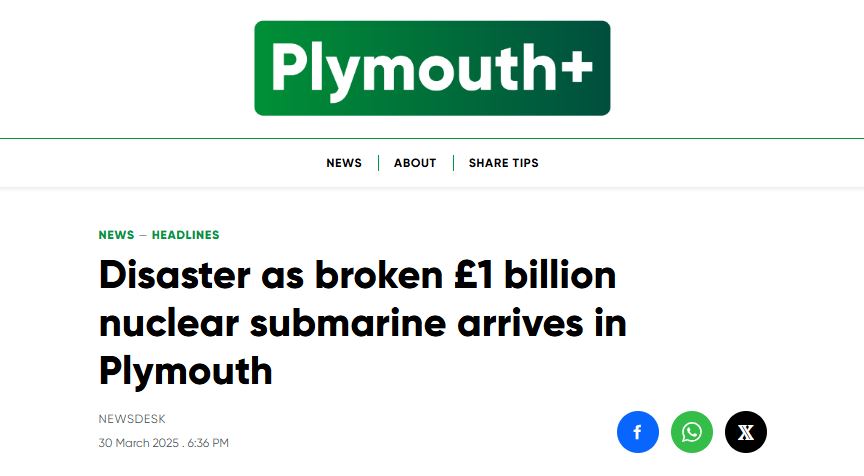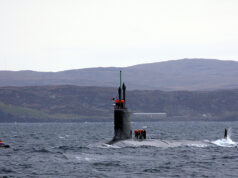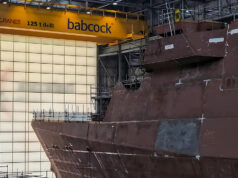A recent article published by Plymouth Plus, titled “Disaster as broken £1 billion nuclear submarine arrives in Plymouth,” has prompted serious discussion within defence circles — not because of whether its central claims are true or false, but because of how the story was constructed: through a combination of unattributed sourcing, unacknowledged edits, and factual inconsistencies that raise questions about editorial process.
The report, which states that the Royal Navy’s HMS Astute arrived with a potentially serious reactor fault, relies on a single unnamed “defence source” and provides no supporting comment from officials, contractors, or independent experts.
Anonymous sources are a valid tool in defence reporting — particularly where security or whistleblowing is involved — but the way in which this story combines unverifiable sourcing, publicly circulating content, and undisclosed changes post-publication has triggered understandable concerns about transparency.
The article’s central allegations — that HMS Astute was towed into Devonport with significant technical issues and may have had armaments removed beforehand — are certainly serious. However, the language, timing, and even some of the phrasing closely match a social media post shared shortly before the piece went live. That post was published by an account with no verifiable defence credentials or professional background in the field.
That same account posted footage of the submarine arriving in full daylight. Yet both it and the original version of the article claimed the arrival happened “under the cover of darkness” — a point that was later amended to “under the cover of dawn,” with no accompanying correction or editorial note. This unannounced change highlights broader concerns around how facts were established and updated.
The footage used by Plymouth Plus also appears to originate from the same location, captured at the same time, and under identical conditions as the social media video — suggesting a possible overlap between the outlet’s source and the online user, or a reliance on publicly available footage without attribution. Either scenario raises reasonable questions about the sourcing chain and the editorial process used to verify it.
When claims about nuclear submarine safety are made, the public has a right to understand the origin of that information. Was it shared by a qualified insider — or sourced from general online commentary?
Transparency, Not Just Attribution
Again, the issue is not anonymity itself. Rather, it’s the lack of disclosed verification, unclear editorial standards, and subsequent revisions without explanation that draw concern.
Responsible reporting with anonymous sources usually includes details on why anonymity was granted, what kind of role the source holds, and how their information was cross-checked. None of that context is provided in this case, and the story’s strong alignment with online speculation adds to the lack of clarity.
Additionally, Plymouth Plus has revised key phrases in the article since publication. For example, “under the cover of darkness” was replaced with “under the cover of dawn,” and “Rolls-Royce engineers were seen observing the arrival” was softened to “reportedly seen.” These changes — made without any public correction or footnote — alter the tone and certainty of the claims, which can affect how readers interpret the piece’s reliability.
Industry norms typically call for an editor’s note or correction notice when a published article is updated in this way. The absence of such transparency here is, in itself, cause for concern.
A Reversal of Journalistic Responsibility
When we asked the person running the outlet about these concerns on Twitter, Plymouth Plus replied:
“Plymouth Plus is trusted by local people and backed by verified facts. Our content has amassed over 20 million views in less than 6 months and we maintain one of the largest and most engaged followings in the city. It’s disappointing, though not surprising, to see yet another attempt to undermine credible local journalism by someone with a long track record of criticising the media rather than spending their time reporting themselves.
Instead of resorting to tired accusations about ‘sourcing integrity’ that don’t hold up to scrutiny, perhaps you should take the time to investigate the matter yourself and produce evidence that disproves our reporting.
When you do, we’ll be the first to apologise — but you won’t, because there’s nothing to find. In the meantime, we actually have a job to do — covering real stories for the people of this city — so we won’t be engaging in this kind of childish distraction any further.”
This response highlights a number of points — not least the emphasis on audience size and engagement metrics, which, while impressive, are not equivalent to editorial transparency or factual verification.
- First, the reference to “20 million views” appears to reflect the popularity of short-form video content, rather than substantiated investigative reporting. High engagement is valuable — but it does not, in itself, demonstrate the accuracy of specific claims.
- Second, the idea that critics must “produce evidence” to disprove a published article reverses a core principle of responsible journalism: that the burden of proof lies with the publisher, especially when the reporting involves serious allegations.
- Finally, characterising valid questions about sourcing, edits, and verification as a “childish distraction” sidesteps the real issue:
- Why do key elements of the article mirror a non-expert social media post?
- Were any of the claims independently verified?
- Why were factual edits made after publication with no correction notice?
Raising these concerns is not an attempt to discredit local journalism — it’s a matter of professional accountability. When public trust is at stake, especially in defence reporting, transparency isn’t optional.
The Bottom Line
To be clear, no newsroom is perfect. We ourselves recently corrected an error involving the timing of a U.S. submarine’s deployment. When it was brought to our attention, we issued a transparent update — because that’s how credible journalism handles its responsibilities.
If there is indeed a technical or safety issue with HMS Astute, that story deserves to be told — and investigated thoroughly. But it must be reported with proper sourcing, editorial transparency, and clear separation between public speculation and verifiable fact.
When online commentary is repackaged as anonymous reporting, and when questions are met with edits and dismissals rather than openness, it doesn’t just affect one article — it risks undermining public confidence in journalism, institutions, and the truth itself.














You just have to look at the polemics in the “About Us” page of “Plymouth Plus” to realise that it’s not a genuine news site. Instead it’s run by those with a political agenda who seek to influence public opinion with fake news like the above. Probably run by the likes of Socialist Workers – maybe they finally realised trying to see their rag on the street doesn’t work.
If they (Socialist Worker) aren’t on the street at least I wont have the opportunity to inadvertently stumble across them and have to control any underlying urge I may have to ‘argue the toss’. If they are only on social media I can just ‘scroll on by’ – although I concur that presence does of course have a more subversive capability.
It’s only been around a few months and it has no address, no listed owners, no business records, and no single person online claiming to work for them.
Add to the fact the source was a right wing conspiracy account claiming to be from Lebanon. This doesn’t seem anywhere close to credible and it’s shocking how much coverage that site gets.
It sounds like a textbook example of an online influence site managed by a foreign actor like China or Russia.
not unlikely that it’s news being spread on purpose by an eastern country that i won’t name..wouldn’t be the first time
Simply political flatulence. Ignore.
The enemy within. As usual.
With an audience within to believe it unfortunately
Hardly different from the editorial standards on the chain of publications called (insert town name) “Live”. Utter gash, for the most part, put together by “journalists” who spend most of the time trawling social media, than out talking to relevant people.
The reasons for this are plain, print media is dying a slow death, and how many readers actually pay for online content?
At least Reach Plc. tell you who’s publishing the drivel in the “live” publications, so we know who to direct ire at. Unlike the publication in question here that’s hidden behind a veil of anonymity.
Such rubbish is easily spotted, just like the April Fools day stuff but as we know from this site, there are many Fools out there.
Tow a sub with a serious reactor problem in to a populated area? Whilst I rage against some of the conduct and non toxic waste emaniting from our MOD. Surely they would see that’s not in their interests. 9 bob note journalism?
They firstly state a “poisoned reactor” and when asked about this they accuse you of being a “sexist” and a “wife beater” .. very libelous accuations which I would be seeking damages against..
One thing to pist lies, but to be called out to this statement is disgusting.. I hope you sue her ro the fullest
Hmm who would stand to benefit from an allegations that a new class of submarine was unreliable and possibly dangerous?
Russia? China? Not really, in fact it is better for them if the mod did cover this up and continue to build and sell a inherently unreliable submarine as that would weaken our defences.
The main beneficiary would be anyone who maybe in competition to sell submarines to others, perhaps carrying a grudge about losing a contract to supply subs to a certain antipodean nation, and wish to rally the anti nuclear mob in said nation hoping that they get the contract back…
The French
In our troubled times, one must be careful of unverified and “poisoned” articles. Poisioned reactor indeed. Very sketchy reporting, if you can call it that…
Welcome to the world of local journalism. Cut and paste. YTS ” journalists ” trawling social media sites looking for stories. Never bothering to check facts, in this case, asking the MoD for a comment. Only nterested in generating income from advertising sites. Pitiful.
Psst Jack ,heard a good Buzz in the Gaddafi queue. Its a Gen dit no Sxxt .And that’s how the story starts. No proof just a line that gets picked up and it becomes a story bigger than Tolstoy War and Peace. Pinch of salt with anything like this Whopper. How come there was no mention of the Dockies wearing hazmat suits when berthing the boat.
I just feel so sorry for the families. I’d be worrying about my partner or family and how they might be suffering the consequences of a nuclear core malfunction. That’s extremely serious! I’d be worried sick! Only to then find out that it’s actually “suggested” and “well maybe almost true”, and my other half is actually fine while I’ve been wondering what to tell the kids about radiation sickness. It’s despicable and shows no respect towards the service people or their families. I think the sensationalist journalism around defense, forget their are real people and their families behind these “disasters”.
It’s amazing that the submarine in question is due to sail FULLY loaded to escort #csg25 to the far east tomorrow (21st April) – yes the other side of the world! some challenge for a submarine that got a “poisoned reactor” and various other issues!
Plymouth+ – still waiting on the apology!
Here is one of their quotes… “It’s safe, but the reactor may be poisoned. That makes it very hard, possibly impossible, to restart”
It’s amazing that the submarine in question sailed this morning FULLY loaded to escort #csg25 to the far east 21st Apri – yes the other side of the world! some challenge for a submarine that got a “poisoned reactor” and various other issues!
Plymouth+ – still waiting on the apology!